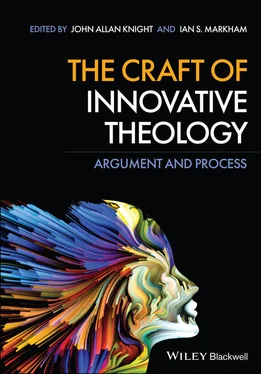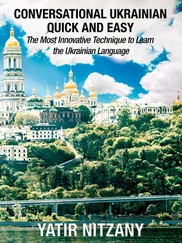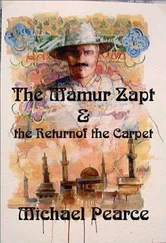Theologically, the doctrine of transcendence, when fully realized, makes it impossible to know God, truly, in any positive sense; that is, we cannot literally attribute any predicates to God, only negations – as in the via negativa of Aquinas or Augustine’s depiction of God as wholly other (see Box 1.6). 5
Box 1.6
It is worth pausing and looking closely at footnote 5. In the text, the author is explaining that God’s transcendence means that we cannot know precisely what God is like. The author is aware that this is the realm of apophatictheology. To discuss this at any length in the text would be a major distraction. Instead, the author uses the note to invite the reader to read an essay on apophatic theology. In this way, he reassures the reader that he is aware of this strand in the literature; and he helpfully directs the reader to a text that can provide a helpful discussion of this approach to theology, namely, Andrew Louth, “Holiness and the Vision of God in the Eastern Fathers,” in Holiness: Past and Present , ed. Stephen C. Barton(London: T&T Clark, 2003), 217–239.
The transcendence of God puts hard limits on what human beings can know about the divine, highlighting the humility with which we must hold theological statements. Of course the doctrine of transcendence, and indeed the scriptures on which they are based, are also balanced by statements that positively ascribe actions and characteristics to God. Aquinas’s theory of analogy makes certain forms of positive religious language possible and sensible, but of course analogical language cannot be said to refer to God directly. We must rely on figurative language to speak, as it were, above our heads, 6while maintaining strict adherence to Divine Otherness lest our words refer to something other than God. 7To be clear, transcendence logically forbids the possibility of literal, positive predication, so the characteristics of God described in scripture and tradition must be suspended in analogical tension. In the light of this tense suspension, the most consistent perspective is that when humans hold a particular view about the divine it must be held lightly, as with an open palm. This is a performance of our humility: we cannot presume to truly know God, yet we are able to understand our relationship to the divine only when we continually recognize the tentative, fallibilistic nature of our ideas.
Most religious traditions accept that language cannot literally refer to God, only analogically or figuratively. Just as the idea of transcendence necessitates a theology which requires epistemic fallibilism as an axiom, analogical predication opens up possibilities of understanding that facilitate and even encourage a religiously plural, creative theology. The flexibility and polysemyinherent in analogical/metaphorical 8language allows for a wide variety of images, metaphors, and symbols to be used in religious language, not all of which necessarily derive from a single tradition. This opens up the possibility of using figures of speech (along with their semantic horizons) deriving from “foreign” language games, resulting in hybrid or creole predication. This is indeed the case for Christian tradition itself, as the first few centuries of its theological development show a synthesis of Jewish and Greco-Roman concepts, language, images, narratives, and symbols: the marriage of Jerusalem and Athens. So if, following George Lindbeck, 9we understand the relationship of theology to religious belief, practice, and tradition on the model of the relationship of grammar to its natural language, then a thoroughly pluralistic theology can be forged through explicit and implicit synthesis of ideas, images, and concepts derived from a variety of religious forms of life. What begins with a humble recognition of fallible and limited human abilities to know the divine leads to a freedom to borrow from a variety of languages and conceptual schemes in order to express what can usefully be said. A humble, creative, pluralistic theology must therefore leave space for such hybridity.
Radical Flexibility: The Principle of Indeterminism
I expect some may be rather queasy about the skeptical trajectory of the principle of fallibilism just described. If we must resist the drive toward certain knowledge and conviction, maintaining, rather, that when all is said and done we might be significantly wrong about central beliefs and practices of a tradition, then in what sense could we hold religious beliefs and practices to be true? Surely, contends the critic, even a theology thoroughly inflected by the facts of religious plurality must have some criteria of justifiable belief? Pushed too far, does not the principle of fallibilism lead to Pyrrhonian skepticism?
The question of truth in theological discourse is, of course, still much debated, and a thorough discussion of it is beyond the scope of this chapter. However, I suggest that a pluralistic theology of religion must avoid the scyllaof a strict correspondence theory of truth, and the charybdis of mere coherence theories, opting, rather, for a pragmatic theory. 10The principle of indeterminism at work here describes a position which maintains that the truth of religious propositions is constructed, negotiated, dynamic, and provisional. Religious truth refers to what particular, historic, and changing religious communities, broadly construed, accept as valuable, constitutive, and trustworthy. “True” is what such communities label the propositions which, generally, work for them; that is, help to deliver the kinds of goods and forms of life commonly valued by those communities. For pluralistic theology, religious truth cannot be fixed forever in objective certitude, for, as Kierkegaard reminds us, objective facts per se do not impinge on our lives. Facts about the universe must be appropriated subjectively in order to have meaning for us.
In his journal of 1835 Kierkegaard writes (see Box 1.7):
Box 1.7
In this description of the second characteristic notice how he goes back to the original sources when outlining the views of Kierkegaard. He does not draw on secondary sources, or descriptions of Kierkegaard’s views, but quotes the actual relevant section of Kiekegaard’s journal.
What would be the use of discovering so-called objective truth, of working through all the systems of philosophy and of being able, if required, to review them all and show up the inconsistencies within each system […] what good would it do me if truth stood before me, cold and naked, not caring whether I recognised her or not, and producing in me a shudder of fear rather than a trusting devotion? 11
Subjectivity is thus the tell-tale of religious truth, as Kierkegaard makes clear through his definition of truth as an “objective uncertainty held fast in an appropriation process of the most passionate inwardness.” 12However, to function as a general theory of truth, this subjectivity must be tested through negotiation and contestation within the relevant religious communities. 13These negotiated settlements shape subjective truth toward the ends valued by particular communities at particular times and places. Truth is thus at the same time the product of contingent, historical processes while being held fast to subjectivity with the greatest trust. It plays an essential and foundational role in the creation and maintenance of a religious community while at the same time continually arising from and responding to the needs, desires, best practices, and values of that dynamic, interactive community. Religious truth understood pragmatically is a continual work in progress, much as even the most established scientific theories are always provisional. Insofar as religious beliefs and practices continue to be effective in bringing about the forms of life cherished by communities, exemplified in their narratives, performed in their rituals, made relatively more permanent in their institutions, held fast to in subjectivity, they are thereby labeled “true.”
Читать дальше











